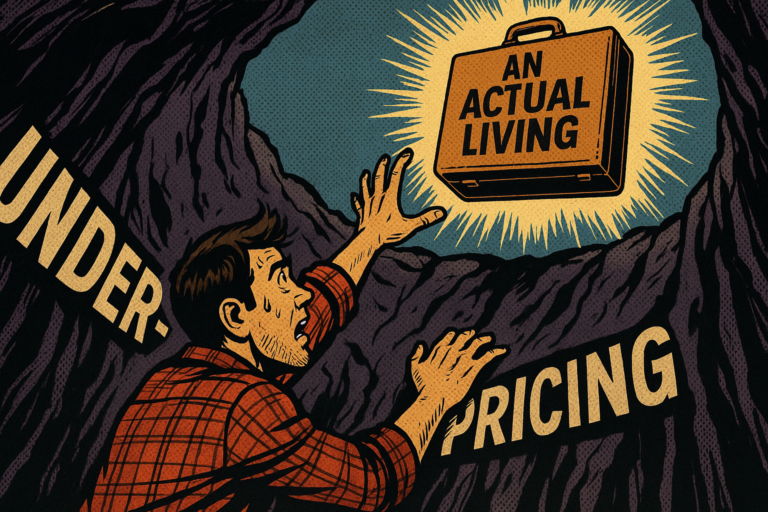Today I’m going to touch on something that I don’t hear a lot of people talking about, especially in this entrepreneurial space. And I believe this is a crucial component of not just sustainable business success, but also sustainable personal financial success.
A few weeks ago, somebody booked a Pick My Brain session, wanting to learn more about how I have my cash flow management system set up. We were having a great chat about business finances, and then the conversation shifted to personal finances, and they asked how I manage my money after I paid myself. And I said, “This would make a great topic for a video and blog post!” So here we are.
It’s important to understand the relationship between business finances and personal finance, especially if you are self employed. You can run a profitable business and make all the money in the world, but if you manage it poorly once it’s in your pocket, then what good is it?
Aligning Your Business Goals with your Personal Goals
Now I’m not going to tell you how you should spend and save your money. That’s determined by you and your personal goals. But I will tell you that you should be thoughtful about how you spend and save your money, and you should also understand that money is a tool, and your business is a tool to help you make more money. I mean, it’s more than that. Business makes connections. It leverages your skills to make an impact on the world and all this good stuff, but I want to take the next few minutes to focus on finances and talk a little bit about lifestyle congruence. That is, making sure your business supports your personal life, and your personal life is supportable by your business.
On one hand, you want to have reasonable and realistic expectations for your lifestyle and make sure that it’s something you can afford based on what you’re bringing in from your business. If you have expensive taste, that’s fine. But if you just started a business and it’s not bringing in that much income right now, you might want to hold off on buying a brand new G Wagon (and, no, you can’t write it off as a business expense. I don’t care what you heard on TikTok).
On the other hand, if you don’t have a clear vision for how your business activities and the revenue you’re generating on that side is going to flow through and help you create financial security and a meaningful life for you and your family, then you’re not going be nearly as motivated to run your business as well as you can. You’re just going to be spinning your wheels making money for the sake of making money. So start by setting some personal goals.
How do you want to use your money? Take care of your family? Go on vacation? Pay off debt, save up for that Charizard, and finally complete your shadowless base set collection? You get to choose. Now, how much money do you need to make in order to achieve these goals?
Figure out how much you need
Make a budget. Actually, make two budgets: One with everything you absolutely need to survive, and another version that’s a bit more comfortable and aspirational. Doing this will help you understand what you need to be paying yourself from your business. And from here, add taxes, insurance, business expenses, all that other fun stuff to work out what sort of top line revenue you need to shoot for and how much you need to be charging your customers.
I always sucked at pricing myself, especially in the early days when I was just running my business as a side gig. My freelance income was just a bonus. It wasn’t my life-line. So I wasn’t really thinking in terms of what I absolutely need. I also wasn’t that confident in the value of my work. So I set my rate based more on fear of what my clients would think is fair (or more fairly, what I thought they would think is fair), instead of me setting my rate based on what I actually need to make a living. A lot of freelancers start out this way, and a lot of freelancers get stuck this way. But now I have clarity on my personal financial needs, and that’s given me the confidence to ask for what I need and keep myself from undercharging.
Quick side note:
Don’t believe the myth that you can never raise your rates on your clients. You can, and you need to. Anyone who’s bought gas or groceries in the past couple years understands that prices go up. Your clients should understand that your prices will need to go up as well to match your rising expenses. If they don’t understand this, please fire them as quickly as you’re able and focus your energy on people who will respect you and pay you what you’re worth. I know this is easier said than done, but it gets easier when you know what you’re worth and how much you need to make. So make a budget.
Budgeting for Beginners
If you’ve never made a budget before, there’s a lot of great resources and templates available. But in a nutshell, start by tracking all of your expenses.
All of them.
List all of your fixed recurring expenses. And then for the less recurring, more irregular expenses (like clothing, gifts, travel, medical emergencies, car repairs, etc.), just try to figure out a rough average and add those all to a spreadsheet. Total it up and then subtract that number from what you are bringing in on average from your business.
Income minus expenses. It’s not hard math, but you need to be thorough.
If the result is a positive number, then we’re on the right track. If it’s a negative number, then we need to do some work. See what expenses you can cut out and also see what opportunities there are to increase your income.
Fine Tuning Your Finances
One of the beautiful things about being self-employed is that you have a lot more freedom to experiment with ways to increase your revenue or ways to reduce your costs. Do you need to raise your rates? Play around with different product offerings, run a new marketing campaign, cut certain business expenses. You get to call the shots and create a better financial picture for yourself.
Now everybody’s situation is different. Again, I’m not gonna tell you how to spend and how to save. I can’t. I don’t know what’s going on.
Maybe your biggest issues lie in how you’re spending money. Maybe the problem is how you’re making money or not enough money. Maybe it’s a little bit of both. Maybe it’s neither. In any case, taking the time to make a budget is time well spent. It will help you see what your money is doing, understand how everything is connected, and see what adjustments you may need to make.
Turn on Autopilot
Now once you have all that mapped out, you know there’s alignment between your business and personal finances, you know you’re living within your means, and there’s money flowing from your business into your personal account, the biggest challenge is staying on track and sticking with the plan.
One of the most helpful things for me is to set as much of your personal finances on autopilot as you can. Similar to how I follow the Profit First system and use Relay’s auto transfer rules to automatically divvy up my income into different buckets, I have auto transfer rules set up for different savings accounts, retirement accounts for my wife, and auto bill pay set up.
I try to automate as much as I can. And I try my best to schedule all these transfers and auto payments as close to my payday as possible (maybe a couple days later so everything has a chance to settle), just so there isn’t a long period of time where there’s a lot of money sitting in my personal checking account tempting me to overspend on miniature golf and Totino’s pizza rolls.
I’ve opened up several Marcus high interest savings accounts, and every month, I’ll transfer a little bit of money into each one for an emergency fund, vacation, vehicle maintenance, home repairs, and other goals that I have. Whatever your goals are, I highly encourage that you set aside a little bit of money each month. Don’t keep it in your main account. Transfer it out to a savings account so you know it’s building up, and it will be there when it’s time to take the kids across country to visit grandma, or if there’s an emergency.
I was going to say something like, “It takes discipline, but it’s worth the peace of mind.” But it doesn’t even take discipline, because all of this can run in the background. You can set all these transfers to happen automatically.
Where should you keep your money?
You can use whatever you like for a savings account. I like Marcus. It’s free. There’s no minimum starting deposit. It pays a decent interest rate (not that we’re trying to get rich off of interest, but doesn’t hurt), and it’s not in my main bank.
Whatever you use, I would recommend using a separate bank to hold your savings. That way, it doesn’t seem like there’s a lot more money in your main account than there really is. It’s out of sight and out of mind until you need it.
I mentioned I also have retirement savings set up (my retirement is actually paid for by my business, and that’s handled on the business side because I’m an S-corp, but that’s another conversation), and I also have a Roth IRA for my wife that gets transferred automatically each month. Maybe you want to save up for your kid’s education. Your goals are your goals. You get to decide what they are and what you want to save for. But by staying disciplined, setting a budget, and understanding how to run your business and manage your personal finances wisely, you’re setting yourself up for long term success and protecting yourself from going into long term debt.
So as we wrap up the year and push through this last minute holiday Shopping Blitz, hold the line, resist temptation, but enjoy your friends and family. Have a very Merry Christmas. And as we enter the new year and you set resolutions, start with a clean slate. I encourage you to take time and set a budget. Make some plans and start heading towards long term sustainable success for your business and your personal finances.


